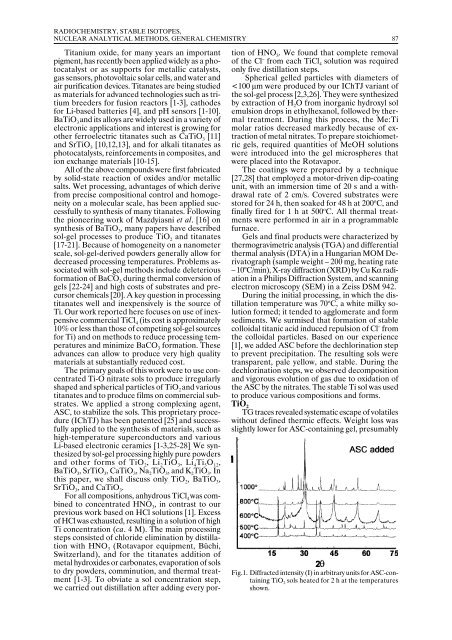annual report annual report annual report annual report 2005
annual report annual report annual report annual report 2005
annual report annual report annual report annual report 2005
You also want an ePaper? Increase the reach of your titles
YUMPU automatically turns print PDFs into web optimized ePapers that Google loves.
RADIOCHEMISTRY, STABLE ISOTOPES,<br />
NUCLEAR ANALYTICAL METHODS, GENERAL CHEMISTRY<br />
87<br />
Titanium oxide, for many years an important<br />
pigment, has recently been applied widely as a photocatalyst<br />
or as supports for metallic catalysts,<br />
gas sensors, photovoltaic solar cells, and water and<br />
air purification devices. Titanates are being studied<br />
as materials for advanced technologies such as tritium<br />
breeders for fusion reactors [1-3], cathodes<br />
for Li-based batteries [4], and pH sensors [1-10].<br />
BaTiO 3 and its alloys are widely used in a variety of<br />
electronic applications and interest is growing for<br />
other ferroelectric titanates such as CaTiO 3<br />
[11]<br />
and SrTiO 3 [10,12,13], and for alkali titanates as<br />
photocatalysts, reinforcements in composites, and<br />
ion exchange materials [10-15].<br />
All of the above compounds were first fabricated<br />
by solid-state reaction of oxides and/or metallic<br />
salts. Wet processing, advantages of which derive<br />
from precise compositional control and homogeneity<br />
on a molecular scale, has been applied successfully<br />
to synthesis of many titanates. Following<br />
the pioneering work of Mazdyiasni et al. [16] on<br />
synthesis of BaTiO 3 , many papers have described<br />
sol-gel processes to produce TiO 2<br />
and titanates<br />
[17-21]. Because of homogeneity on a nanometer<br />
scale, sol-gel-derived powders generally allow for<br />
decreased processing temperatures. Problems associated<br />
with sol-gel methods include deleterious<br />
formation of BaCO 3 during thermal conversion of<br />
gels [22-24] and high costs of substrates and precursor<br />
chemicals [20]. A key question in processing<br />
titanates well and inexpensively is the source of<br />
Ti. Our work <strong>report</strong>ed here focuses on use of inexpensive<br />
commercial TiCl 4 (its cost is approximately<br />
10% or less than those of competing sol-gel sources<br />
for Ti) and on methods to reduce processing temperatures<br />
and minimize BaCO 3 formation. These<br />
advances can allow to produce very high quality<br />
materials at substantially reduced cost.<br />
The primary goals of this work were to use concentrated<br />
Ti-O nitrate sols to produce irregularly<br />
shaped and spherical particles of TiO 2 and various<br />
titanates and to produce films on commercial substrates.<br />
We applied a strong complexing agent,<br />
ASC, to stabilize the sols. This proprietary procedure<br />
(IChTJ) has been patented [25] and successfully<br />
applied to the synthesis of materials, such as<br />
high-temperature superconductors and various<br />
Li-based electronic ceramics [1-3,25-28] . We synthesized<br />
by sol-gel processing highly pure powders<br />
and other forms of TiO 2 , Li 2 TiO 3 , Li 4 Ti 5 O 12 ,<br />
BaTiO 3 , SrTiO 3 , CaTiO 3 , Na 2 TiO 3 , and K 2 TiO 3 . In<br />
this paper, we shall discuss only TiO 2 , BaTiO 3 ,<br />
SrTiO 3 , and CaTiO 3 .<br />
For all compositions, anhydrous TiCl 4 was combined<br />
to concentrated HNO 3 , in contrast to our<br />
previous work based on HCl solutions [1]. Excess<br />
of HCl was exhausted, resulting in a solution of high<br />
Ti concentration (ca. 4 M). The main processing<br />
steps consisted of chloride elimination by distillation<br />
with HNO 3 (Rotavapor equipment, Büchi,<br />
Switzerland), and for the titanates addition of<br />
metal hydroxides or carbonates, evaporation of sols<br />
to dry powders, comminution, and thermal treatment<br />
[1-3]. To obviate a sol concentration step,<br />
we carried out distillation after adding every portion<br />
of HNO 3 . We found that complete removal<br />
of the Cl – from each TiCl 4<br />
solution was required<br />
only five distillation steps.<br />
Spherical gelled particles with diameters of<br />
















